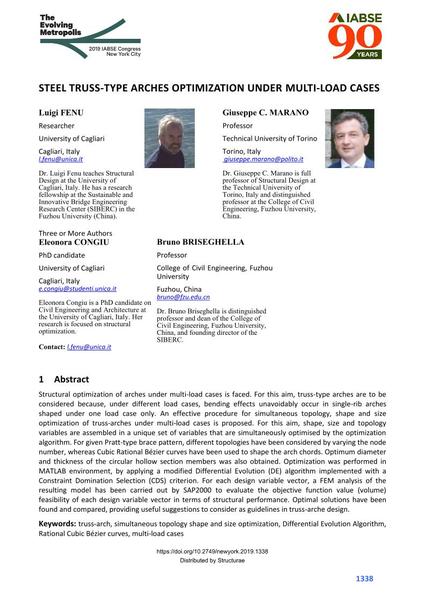Steel Truss-Type Arches Optimization Under Multi-Load Cases

|
|
|||||||||||
Bibliografische Angaben
| Autor(en): |
Luigi Fenu
(University of Cagliari)
Giuseppe C. Marano (Technical University of Torino) |
||||
|---|---|---|---|---|---|
| Medium: | Tagungsbeitrag | ||||
| Sprache(n): | Englisch | ||||
| Tagung: | IABSE Congress: The Evolving Metropolis, New York, NY, USA, 4-6 September 2019 | ||||
| Veröffentlicht in: | The Evolving Metropolis | ||||
|
|||||
| Seite(n): | 1338-1344 | ||||
| Anzahl der Seiten (im PDF): | 7 | ||||
| DOI: | 10.2749/newyork.2019.1338 | ||||
| Abstrakt: |
Structural optimization of arches under multi-load cases is faced. For this aim, truss-type arches are to be considered because, under different load cases, bending effects unavoidably occur in single-rib arches shaped under one load case only. An effective procedure for simultaneous topology, shape and size optimization of truss-arches under multi-load cases is proposed. For this aim, shape, size and topology variables are assembled in a unique set of variables that are simultaneously optimised by the optimization algorithm. For given Pratt-type brace pattern, different topologies have been considered by varying the node number, whereas Cubic Rational Bézier curves have been used to shape the arch chords. Optimum diameter and thickness of the circular hollow section members was also obtained. Optimization was performed in MATLAB environment, by applying a modified Differential Evolution (DE) algorithm implemented with a Constraint Domination Selection (CDS) criterion. For each design variable vector, a FEM analysis of the resulting model has been carried out by SAP2000 to evaluate the objective function value (volume) feasibility of each design variable vector in terms of structural performance. Optimal solutions have been found and compared, providing useful suggestions to consider as guidelines in truss-arche design. |
||||
